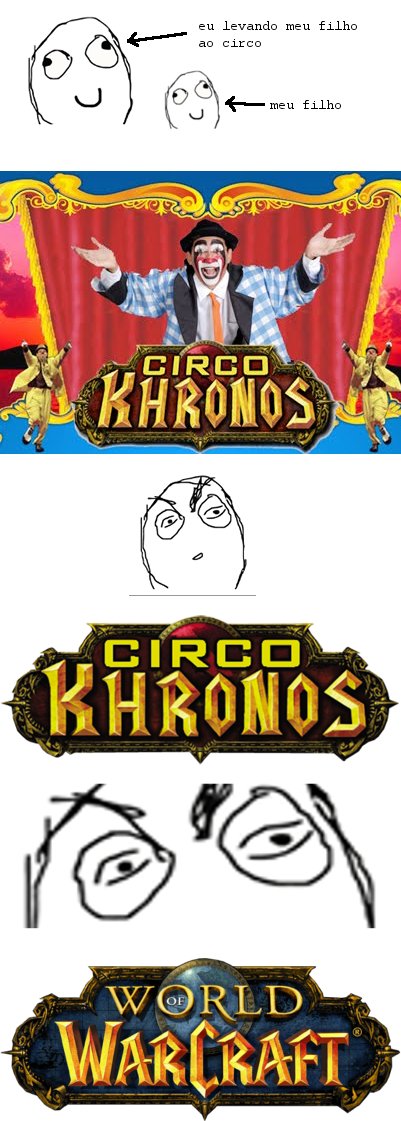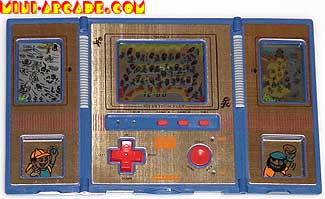Já tem vários anos que não jogo Nethack direito, mas um tempo atrás tentei fazer um patch para acrescentar mais uma classe no jogo, o Bardo.
Arquivo da tag: Games
World of Circo Khronos

Treasure Island
Memórias de infância:

Não lembro onde isso foi comprado, mas tinha quando criança e muito joguei. O jogo começava no painel da esquerda, onde o personagem tinha que tentar chegar na ilha, fugindo de tubarões e um polvo. No painel do meio você ficava jogando o tempo que quisesse, desviando dos fantasmas e catando tesouros, mas com o tempo apareciam mais fantasmas e iam ficando mais rápidos. Por fim, no painel da direita era para tentar ir embora da ilha, desviando de pedras jogadas por um pirata. Simplesinho mas bom para a época.
Rogue'm Up 0.1
Atualização do Rogue’m Up. Agora é um pouquinho mais bonito e será usado para exemplificar técnicas simples de programação em C. Aqui:Update of Rogue’m Up. Now it’s a bit less ugly and will be used to show some simple C programming techniques. Here: Rogue’m Up project
Rogue'm Up
English version below.

Uns dois anos atrás, comprei numa promoção o livro Linux Application Development, e até hoje não consegui acabar de lê-lo. Acontece sempre isso com todo livro técnico que compro. Nunca consigo ler pelo menos um parágrafo de uma só sentada, sempre perco o interesse e vou fazer outra coisa.
Resolvi então mudar de estratégia: vou lendo os capítulos fora de ordem, procurando por temas que me interessem no momento. Vi então que o livro tem um capítulo sobre uso da lib S-lang, que serve para abstrair o acesso ao terminal (console). Tradicionalmente se usa a biblioteca ncurses, mas a S-Lang parece ser mais moderna.
Enfim, não só finalmente li um pouco mais do livro, como comecei a brincar com as funções da S-Lang e fiz um pequeno jogo, um shooter lateral, com o mesmo. Como a nave é representada pelo caracter @ e os inimigos são, digamos, familiares para quem já jogou um certo jogo em modo caractere, resolvi chamar este de Rogue’m Up – mistura de Roguelike com Shoot’em Up.
Ou seja, é um shooter para se jogar em modo caractere. Não espere nada muito bem feito, afinal foi só o resultado de uma tarde brincando com as funções da lib S-Lang. Movimente-se com as teclas wasd ou hjklyubn (todas minúsculas), atire com o espaço, saia com Q (maiúsculo). Cada colisão com um inimigo tira 2 pontos de HP.
Atualizado: agora com mais de uma versão e usado como exemplo de programação em C, aqui.

Two years or so ago I bought the book Linux Application Development at bargain price, but I still didn’t finished reading it. This always happens with all technical books I bought: I sit down to read the book, and before I finish even a chapter, I shift my attention to something else and drop the book.
I decided to change my strategy: now I’ll try reading the chapters out of order, selecting chapters by its themes, looking for something I’m interested in reading at that moment. Then I found that this book had a chapter about the S-lang lib. S-Lang provides an abstraction of the terminal (console), easing the programming of console applications. Traditionally the ncurses lib is more used and talked about, but S-Lang seems to be updated more often.
So I’ve finally advanced a little more in reading this book, and also spent some time playing with the S-Lang functions, enough to make a small game – a lateral shooter. The ship is an @ character and the enemies are, let’s say, somewhat familiar to anyone who ever played a certain character-mode game. And so I named this little experiment Rogue’m Up – from the wordsRoguelike and Shoot’em Up.
In other words, it’s a character-mode shooter. Don’t expect anything nice, this was just a result of an afternoon’s play with the S-Lang lib functions. Move the ship with the keys wasd or hjklyubn (all lowercase), shoot with the spacebar, quit with Q (uppercase). Every time an enemy collides with you, you lose 2 HP.
Updated: now with more than one version and used as example of C programming, here.
Plonq
English version below.
Faz um tempo que encontrei por acaso um joguinho chamado Qonk. Simples, pequeno, mas criativo. Exige estratégia e rapidez. Basicamente, o objetivo é conquistar um sistema solar, eliminando os concorrentes, conquistando outros planetas, e usando as naves espaciais produzidas por esses planetas para conquistar outros.
Também faz um tempo que conheci a linguagem Lua. Simples, pequena, mas criativa e bem flexível. E para conhecer melhor a linguagem e brincar um pouquinho com ela, instalei uma variante da mesma no meu Palm Tungsten: Plua. Como a melhor forma de aprender uma linguagem de programação é escrever um programa nela, resolvi tentar fazer um joguinho: um pequeno clone do Qonk. O jogo ainda não está completo mas já está funcional. Coloquei o jogo e o código fonte aqui:
Plonq
Some time ago I found a little game called Qonk. Simple but creative, it requires strategy and quick thinking. Basically, the goal is to conquest a solar system, eliminating the adversaries, conquering more planets, and using the spaceships produced by those planets to conquer others.
Some time ago, I also knew the Lua language. Simple, small, but creative and flexible. And in order to know it better, I installed a variant of it in my Plam Tungsten: Plua. Since the better way to learn a new programming language is to write a program in it, I decided to try making a little game: a Qonk clone. The game isn’t complete yet but already works. I’ve uploaded the game and its source code here:
Plonq
Pac-Man explained
English version below.
Lembram do romor sobre o filme do Pac-Man que rolou um tempo atrás? Bem, isto não tem conexão com o filme, mas provavelmente poderia ser a única explicação racional para a história do Pac-Man…
http://www.chrisroberson.net/2008/05/pac-man.html
Eu quero uma camiseta com essa imagem.
Remember the Pac-Man movie rumor a while back? Well, this is not connected to the movie, but this probably could be the only rational explanation behind Pac-Man’s story…
http://www.chrisroberson.net/2008/05/pac-man.html
I want a T-shirt with that pic.
Pac-man, o filme
 Vão fazer um filme baseado no jogo de Pac-man.
Vão fazer um filme baseado no jogo de Pac-man.
Sem sacanagem. É sério.
Vão fazer um FILME sobre o PAC-MAN.
Não, não é primeiro de abril. Clique aqui e leia a notícia, original em inglês.
E depois de ficar estupefato por alguns minutos, tente pensar comigo que raio de roteiro um filme desses poderia ter. Um personagem redondinho, correndo em um labirinto escuro, engolindo pílulas atrás de pílulas e assombrado por fantasmas. Infantil? Terror? Comédia? Trash? Nenhuma das anteriores? Meu Deus.
Isso me lembra um comentário que vi no Slashdot.org uns dez anos atrás, em uma discussão sobre a influência dos videogames no comportamento dos jovens (principalmente no tocante à influenciar a violência): um camarada argumentou que, se os videogames influenciassem os jovens, eles estariam “andando por aí em salas escuras, ouvindo música eletrônica repetitiva e chata, e engolindo pílulas” (obviamente se referindo ao jogo de Pac-man). Imediatamente alguém respondeu: “isso aí não é uma rave?”
Até onde eu saiba, o Uwe Boll não está envolvido no projeto.
WordPress theme: I Miss the Pixels

For the ones that miss the ol’ good graphics from games of the Atari 2600 and the Odyssey2.Para os saudosistas dos gráficos de jogos do Atari 2600 e do Odyssey2.
Download (35KB)
I miss the pixels
Descoberto através do Jacaré Banguela: GAMMA BROS, um joguinho em Flash com pixels de sobra.
